Where Does Customer Service Fit On The Org Chart
Choosing the best organizational construction for your company, division, or team is a lot like picking out a new car. At the virtually basic level, you're ever looking for something road-worthy — something that can accept yous (and your passengers) from point A to bespeak B without a hitch. Merely across that, at that place are a lot of options to consider. Automatic or manual? Four-wheel drive or ii? Congenital-in GPS? Leather interior? Flux capacitor? (Only if you're going back in fourth dimension, of course.) In the world of organizational structures, the options you have to choose from include things like chain of command (long or short?), span of control (broad or narrow?), and centralization (centralized or decentralized decision-making?), only to name a few. An organizational structure is a visual diagram of a company that describes what employees exercise, whom they report to, and how decisions are made across the business concern. Organizational structures can use functions, markets, products, geographies, or processes as their guide, and cater to businesses of specific sizes and industries. What'due south the point of an organizational structure? Equally a business leader, do you lot even demand 1? As I said, org structures help yous define at least three key elements of how your concern is going to run. As your visitor gets bigger, an organizational structure can also be helpful for new employees as they learn who manages what processes at your company. So, if you lot need to pivot or shift your leadership, y'all can visualize how the work flows would work past adjusting your organizational structure diagrams. To put it simply, this chart is like a map that but explains how your company works and how its roles are organized. Here'due south what each of those elements means to an organization: Your chain of command is how tasks are delegated and work is approved. An org structure allows you to define how many "rungs of the ladder" a particular department or business line should have. In other words, who tells whom to do what? And how are bug, requests, and proposals communicated upwards and downwards that ladder? Your span of control tin can stand for ii things: who falls under a manager's, well, management ... and which tasks autumn under a department'due south responsibleness. Centralization describes where decisions are ultimately made. Once y'all've established your concatenation of command, you'll demand to consider which people and departments have a say in each conclusion. A business can lean toward centralized, where final decisions are made by just 1 or 2 entities; or decentralized, where concluding decisions are made within the team or department in accuse of carrying out that determination. You lot might not need an org structure right away, simply the more products you develop and people y'all rent, the harder it'll exist to lead your company without this crucial diagram. (To swoop deeper into what all of these unlike organizational structure components are, check out my earlier post, "The vi Building Blocks of Organizational Structure.") In this mail service, nosotros'll explore how you tin can combine those components to class different types of organizational structures. We'll besides highlight the benefits and drawbacks of unlike structure types so y'all can evaluate which is the best option for your company, division, or team. Permit's dive in. Organizational structures fall on a spectrum, with "mechanistic" at i end and Take a await at the diagram beneath. Every bit you'll probably exist able to tell, the mechanistic construction represents the traditional, top-down arroyo to organizational structure, whereas the organic structure represents a more collaborative, flexible approach. Here's a breakdown of both ends of the structural spectrum, their advantages and disadvantages, and which types of businesses are suited for them. Mechanistic structures, also called bureaucratic structures, are known for having narrow spans of control, as well equally loftier centralization, specialization, and formalization. They're also quite rigid in what specific departments are designed and permitted to do for the visitor. This organizational structure is much more formal than organic construction, using specific standards and practices to govern every conclusion the concern makes. And while this model does hold staff more accountable for their work, it can get a hindrance to the inventiveness and agility the organization needs to go along up with random changes in its market. Equally daunting and inflexible every bit mechanistic construction sounds, the chain of command, whether long or short, is e'er clear nether this model. Equally a company grows, information technology needs to make sure everyone (and every team) knows what'south expected of them. Teams collaborating with other teams as needed might assist get a business off the ground in its early stages, but sustaining that growth — with more people and projects to proceed runway of — will eventually crave some policymaking. In other words, keep mechanistic structure in your back pocket ... you never know when y'all'll need it. Organic structures (besides known as "flat" structures) are known for their wide spans of command, decentralization, low specialization, and loose departmentalization. What'due south that all hateful? This model might accept multiple teams answering to one person and taking on projects based on their importance and what the squad is capable of — rather than what the team is designed to practise. Every bit you can probably tell, this organizational structure is much less formal than mechanistic, and takes a flake of an advert-hoc arroyo to business needs. This can sometimes make the concatenation of command, whether long or short, difficult to decipher. And as a effect, leaders might give certain projects the green light more quickly but crusade confusion in a project's division of labor. Nonetheless, the flexibility that an organic construction allows for tin be extremely helpful to a business that'southward navigating a fast-moving industry, or but trying to stabilize itself subsequently a crude quarter. It also empowers employees to try new things and develop every bit professionals, making the arrangement's workforce more powerful in the long run. Lesser line? Startups are oft perfect for organic structure, since they're simply trying to gain brand recognition and become their wheels off the ground. Now, let's uncover more specific types of organizational structures, nearly of which fall on the more traditional, mechanistic side of the spectrum. Depending on the size of a business and its goals, the organizational structure of the team will vary. Each type has its advantages and disadvantages; however, in that location is a universal do good to establishing a clear organizational construction. It helps employees empathize their role within a company, which enables them to manage expectations and goals. A business needs to have an organizational structure in place to be successful. There are several types of organizational structures usually used by companies, 9 of which we aggrandize upon beneath. Ane of the most common types of organizational structures, the functional structure departmentalizes an organization based on common job functions. An system with a functional org structure, for instance, would grouping all of the marketers together in 1 section, grouping all of the salespeople together in a separate department, and group all of the client service people together in a tertiary department. Download this Template The functional construction allows for a high degree of specialization for employees, and is easily scalable should the organization grow. Also this construction is mechanistic in nature — which has the potential to inhibit an employee's growth — putting staff in skill-based departments tin can still allow them to delve deep into their field and notice out what they're good at. Functional construction also has the potential to create barriers between different functions — and it can be inefficient if the arrangement has a variety of different products or target markets. The barriers created between departments tin can besides limit peoples' knowledge of and communication with other departments, especially those that depend on other departments to succeed. Functional arrangement increases efficiency, provides stability, and boosts accountability. It allows departments — with employees who share like skills and knowledge — to focus on their specialized tasks within their respective fields. Because the roles and responsibilities of this organizational structure example rarely change, section employees can consistently piece of work on similar assignments and hone their skills. The fixed construction of functional organisation also operates through management. It provides employees with a chain of command. Information technology guides communication between the team and keeps the team accountable. A divisional organizational construction is comprised of multiple, smaller functional structures (i.eastward. each division within a divisional construction tin take its own marketing team, its own sales team, and so on). In this case — a production-based divisional structure — each division inside the organization is dedicated to a detail product line. This type of structure is ideal for organizations with multiple products and tin can assist shorten product evolution cycles. This allows small businesses to go to market with new offerings fast. It can be difficult to scale nether a product-based divisional structure, and the system could cease up with duplicate resource as different divisions strive to develop new offerings. Companies and their employees can experience the benefits of the production-based bounded structure. If one sectionalization performs poorly, this does not automatically translate across the arrangement. Because of their separation, divisions may flourish (or neglect) concurrently. This system allows companies to mitigate chance. Some other variety of the divisional organizational structure is the marketplace-based structure, wherein the divisions of an organization are based effectually markets, industries, or client types. The market-based structure is ideal for an organization that has products or services that are unique to specific market segments, and is especially effective if that organization has advanced knowledge of those segments. This organizational structure also keeps the business constantly aware of demand changes amongst its unlike audience segments. Too much autonomy inside each market-based squad can lead to divisions developing systems that are incompatible with one another. Divisions might also end up inadvertently duplicating activities that other divisions are already handling. Because this organizational structure focuses on specific market place segments, it provides each sectionalisation with autonomy. The divisions work separately, which allows employees to work independently and enables them to focus on the needs of their particular industry. The geographical organizational structure establishes its divisions based on — you lot guessed information technology — geography. More specifically, the divisions of a geographical construction can include territories, regions, or districts. This type of construction is all-time-suited to organizations that demand to exist near sources of supply and/or customers (due east.g. for deliveries or for on-site support). Information technology also brings together many forms of business expertise, assuasive each geographical division to brand decisions from more various points of view. The main downside of a geographical org structure: It can be like shooting fish in a barrel for conclusion- making to go decentralized, equally geographic divisions (which can exist hundreds, if not thousands of miles away from corporate headquarters) often accept a neat deal of autonomy. And when yous accept more than than 1 marketing department — 1 for each region — you lot run the risk of creating campaigns that compete with (and weaken) other divisions beyond your digital channels. Geographical divisions allow companies the advantage of catering to a specific customer. Based on the differences in language, civilization, and customs one would find across the world, companies cannot necessarily look the same operations to piece of work in dissimilar locations. Non just does it let organizations to tailor their approach based on geography, simply it allows the division to react speedily and efficiently to any geographical market place changes. Process-based organizational structures are designed around the cease-to-end flow of unlike processes, such as "Inquiry & Evolution," "Customer Acquisition," and "Gild Fulfillment." Unlike a strictly functional structure, a procedure-based structure considers not only the activities employees perform, but also how those different activities interact with 1 another. In society to fully understand the diagram beneath, you need to expect at it from left to correct: The client acquisition process can't start until you have a fully developed product to sell. Past the same token, the social club fulfillment process can't commencement until customers take been acquired and there are production orders to fill. Process-based organizational construction is ideal for improving the speed and efficiency of a business concern, and is best-suited for those in rapidly changing industries, as it is easily adaptable. Similar to a few other structures on this list, procedure-based structure can cock barriers between the dissimilar process groups. This leads to problems communicating and handing off piece of work to other teams and employees. Every bit mentioned, one of the most meaning benefits of the procedure-based structure is that it increases efficiency and speed. If Section B cannot kickoff its processes until Department A finishes, this compels Department A to work promptly and proficiently. This organizational model likewise promotes intradepartmental (within the department) and interdepartmental (beyond multiple departments) teamwork. Unlike the other structures nosotros've looked at so far, a matrix organizational structure doesn't follow the traditional, hierarchical model. Instead, all employees (represented past the green boxes) have dual reporting relationships. Typically, there is a functional reporting line (shown in blueish) as well as a product- based reporting line (shown in yellow). When looking at a matrix construction org chart, solid lines stand for strong, direct-reporting relationships, whereas dotted lines indicate that the relationship is secondary, or not as strong. In our example below, information technology'south clear that functional reporting takes precedence over product-based reporting. The primary entreatment of the matrix construction is that it can provide both flexibility and more balanced decision-making (every bit at that place are two chains of control instead of just ane). Having a single project overseen by more than 1 business line as well creates opportunities for these business lines to share resources and communicate more than openly with each other — things they might non otherwise be able to exercise regularly. The main pitfall of the matrix organizational structure? Complexity. The more layers of blessing employees accept to go through, the more confused they can be about who they're supposed to reply to. This confusion can ultimately cause frustration over who has authority over which decisions and products — and who'south responsible for those decisions when things go wrong. An advantage of a matrix structure is that it promotes collaboration and communication. This open line of communication ultimately allows businesses to share resource and allows employees to develop new skills from working with different departments. While information technology might appear drastically different from the other organizational structures highlighted in this section, the round structure still relies on hierarchy, with higher-level employees occupying the inner rings of the circle and lower-level employees occupying the outer rings. That being said, the leaders or executives in a circular organization aren't seen as sitting atop the organization, sending directives down the chain of command. Instead, they're at the heart of the organization, spreading their vision outward. Download the Template From an ideological perspective, a circular structure is meant to promote communication and the free flow of information betwixt different parts of the organization. Whereas a traditional structure shows dissimilar departments or divisions as occupying individual, semi-democratic branches, the circular structure depicts all divisions as existence office of the same whole. From a applied perspective, the round structure can be confusing, specially for new employees. Unlike with a more traditional, top-downwardly construction, a circular structure tin make it hard for employees to figure out who they written report to and how they're meant to fit into the organization. Most examples of organizational structure take a meridian-down hierarchy. Alternatively, this blazon of construction follows an outward flow and contributes to information flowing freely beyond the business. Its benefits include keeping all employees aligned with the processes and goals of the company and encouraging employees to interact between departments. While a more traditional organizational structure might await more than similar a pyramid — with multiple tiers of supervisors, managers and directors between staff and leadership, the apartment structure limits the levels of management so all staff are but a few steps abroad from leadership. Information technology also might non ever take the form or a pyramid, or any shape for that matter. As we mentioned earlier, Information technology's likewise a form of the "Organic Structure" nosotros noted higher up. If there's a time when teams in a apartment arrangement disagree on something, such as a project, information technology tin can be hard to get aligned and dorsum on rails without executive decisions from a leader or manager. Considering of how complicated the structure's design is, information technology can be tricky to determine which manager an employee should become to if they need approval or an executive decision for something. So if yous exercise cull to accept a flat organization, yous should take a conspicuously marked tier of management or path that employers can refer to when they run into these scenarios. The emptying of middle management employees defines the apartment structure type. Its advantages are instantaneous. Outset, it reduces the expenses of the company. 2nd, it allows staff to build straight relationships with upper direction. And lastly, it shortens the decision-making process. A network structure is often created when i visitor works with another to share resources — or if your company has multiple locations with different functions and leadership. You might as well employ this construction to explicate your company workflows if much of your staffing or services is outsourced to freelancers or multiple other businesses. The structure looks about the same as the Divisional Structure, shown to a higher place. All the same, instead of offices, information technology might listing outsourced services or satellite locations outside of the role. If your company doesn't do everything nether 1 roof, this is a great way to show employees or stakeholders how outsourcing of off-site processes work. For example, if an employee needs help from a web programmer for a blogging project and the company's spider web developers are outsourced, the could await at this blazon of chart and know which office or which person to contact outside of their own work location. The shape of the chart can vary based on how many companies or locations y'all're working with. If it's non kept uncomplicated and clear, there may exist a lot of confusion if multiple offices or freelancers practice similar things. If you practise outsource or have multiple part locations, brand sure your org chart clearly states where each specific part and job role lies so someone can easily understand your basic company processes. The outsourcing nature of the network structure provides companies with the advantages of lower costs, more focus, and increased flexibility. Outsourcing allows organizations to save coin, as they don't have to conduct the expense of setting upwards a department for the same purpose. Information technology also gives companies the flexibility to alter their processes and the power to focus on their core functions. Imagine a business that has no organizational structure. Instantly, questions arise about the systems and processes. Who makes the decisions? How are employees held accountable? What are the visitor's goals? These questions are practically incommunicable to answer without a functional organizational construction. Organizational construction is necessary for running a successful business because it improves workflow and efficiency, promotes advice, identifies company needs, and aligns employees with company goals. It directly affects how a business organisation operates daily. When a visitor establishes a construction that works, the combined efforts of its employees, in conjunction with its systems and processes, allow the company to brand amend decisions for its futurity. Organizational structures are central to a successful team. Employees can move comfortably, confidently, and efficiently when given a clear definition of their role within an organization. Structure types will vary from business to business, then information technology's important to remember that these structures are non one size fits all. Every type may not adapt your organization, just chances are, one of them will. Use this post to determine which organizational construction works for you, and then information technology's fourth dimension for the real piece of work to begin. Editor's note: This post was originally published in December 2014 and has been updated for comprehensiveness. ![→ Download Now: The Illustrated Guide to Org Charts [Free Guide + Templates]](https://no-cache.hubspot.com/cta/default/53/7cbd0328-6c8c-40e0-98dd-c3b6e6be96f0.png)
Organizational Structure
Chain of Control
Span of Control
Centralization
Mechanistic vs. Organic Organizational Structures
"organic" at the other.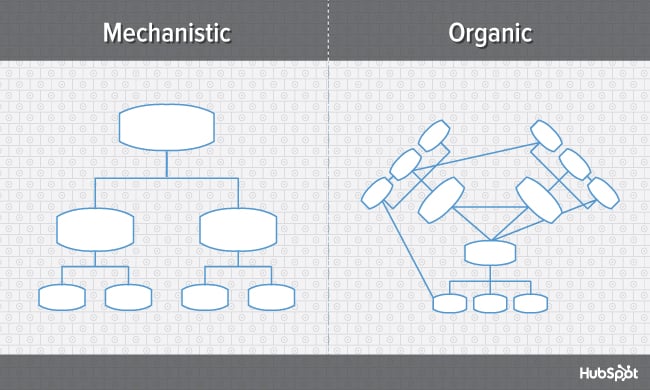
Mechanistic Construction
Organic Structure
Types of Organizational Structure
1. Functional Organizational Construction
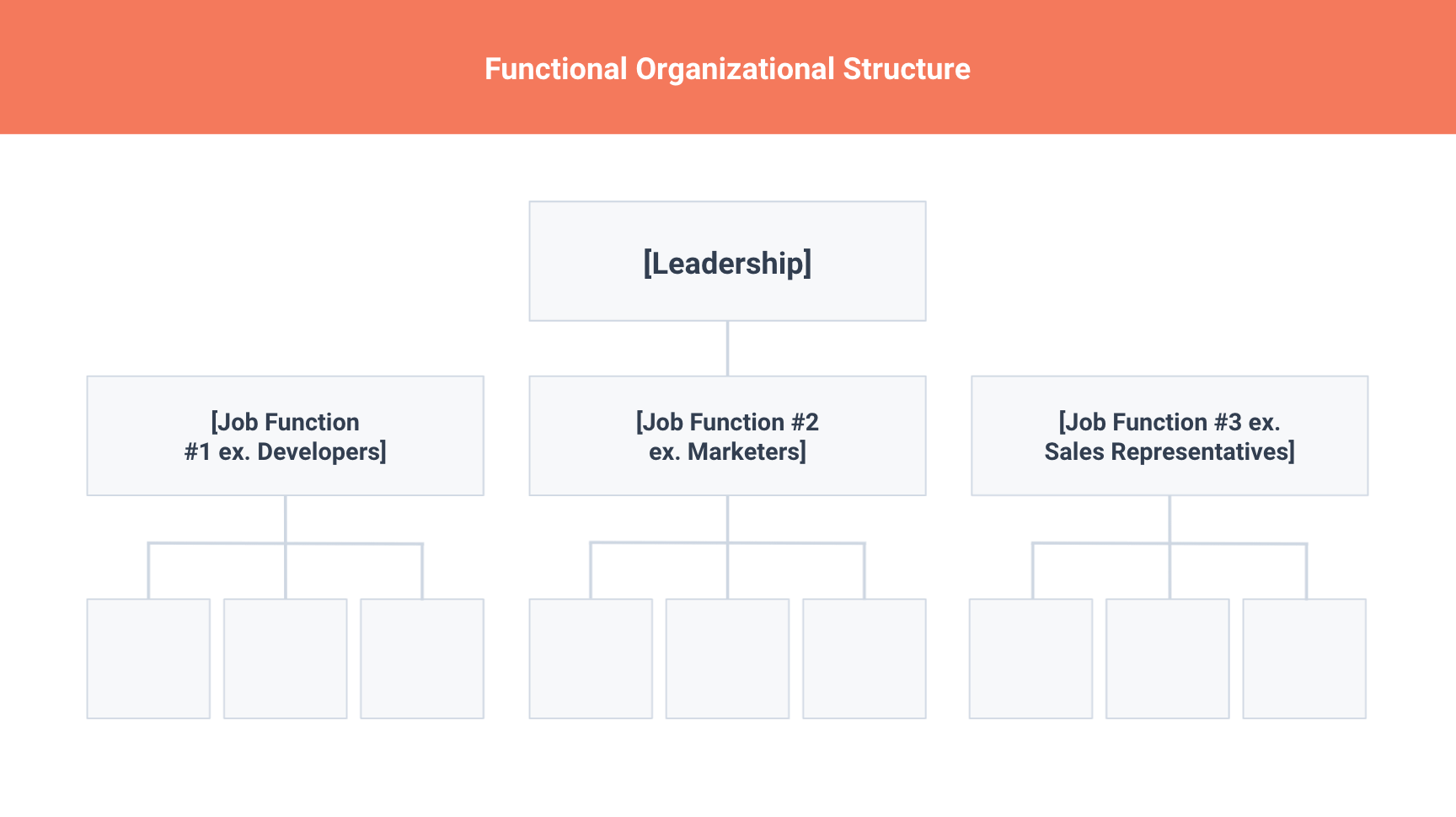
Disadvantages
Advantages
2. Product-Based Divisional Construction
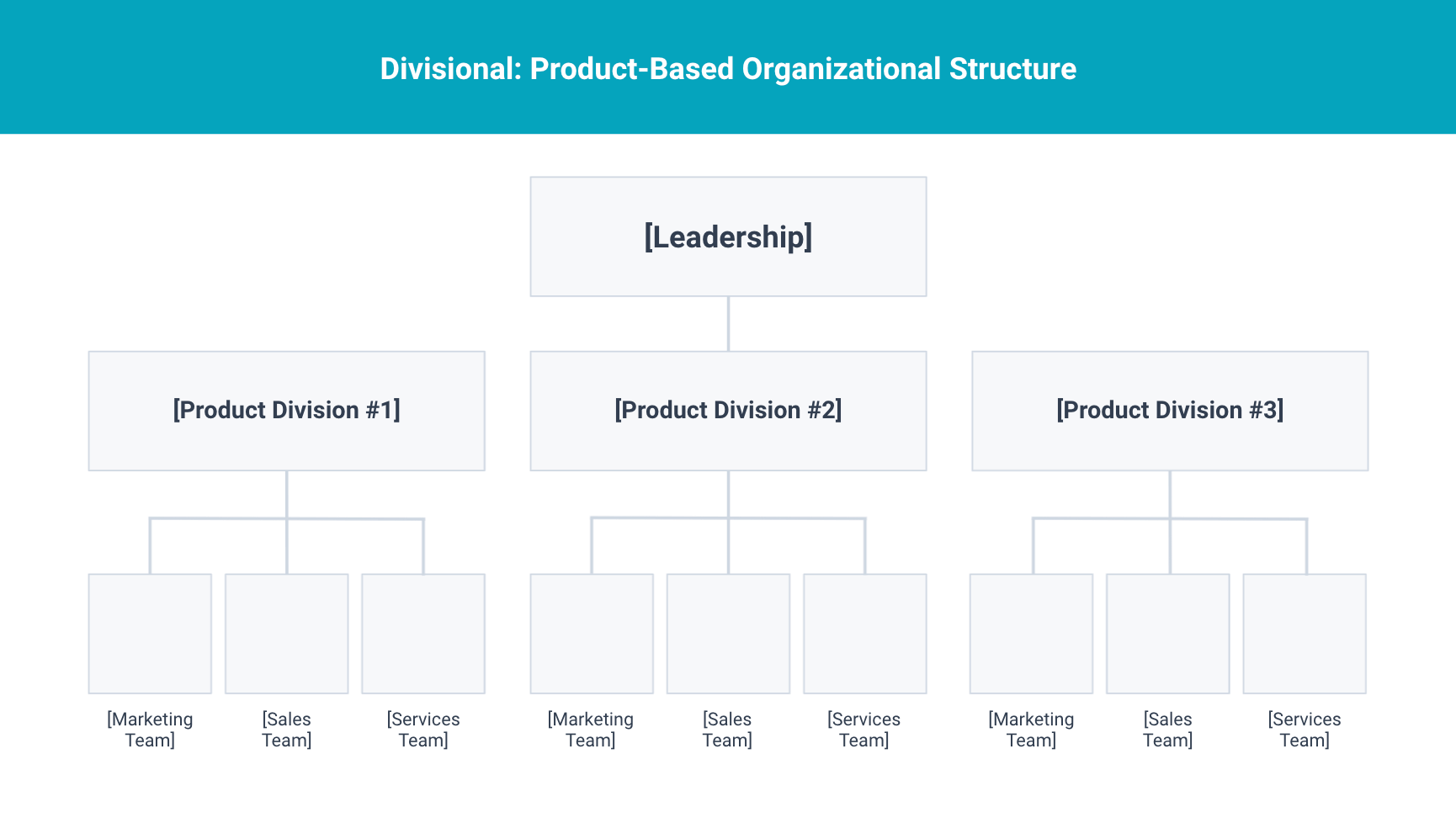 Download this Template
Download this TemplateDisadvantages
Advantages
three. Market-Based Bounded Structure
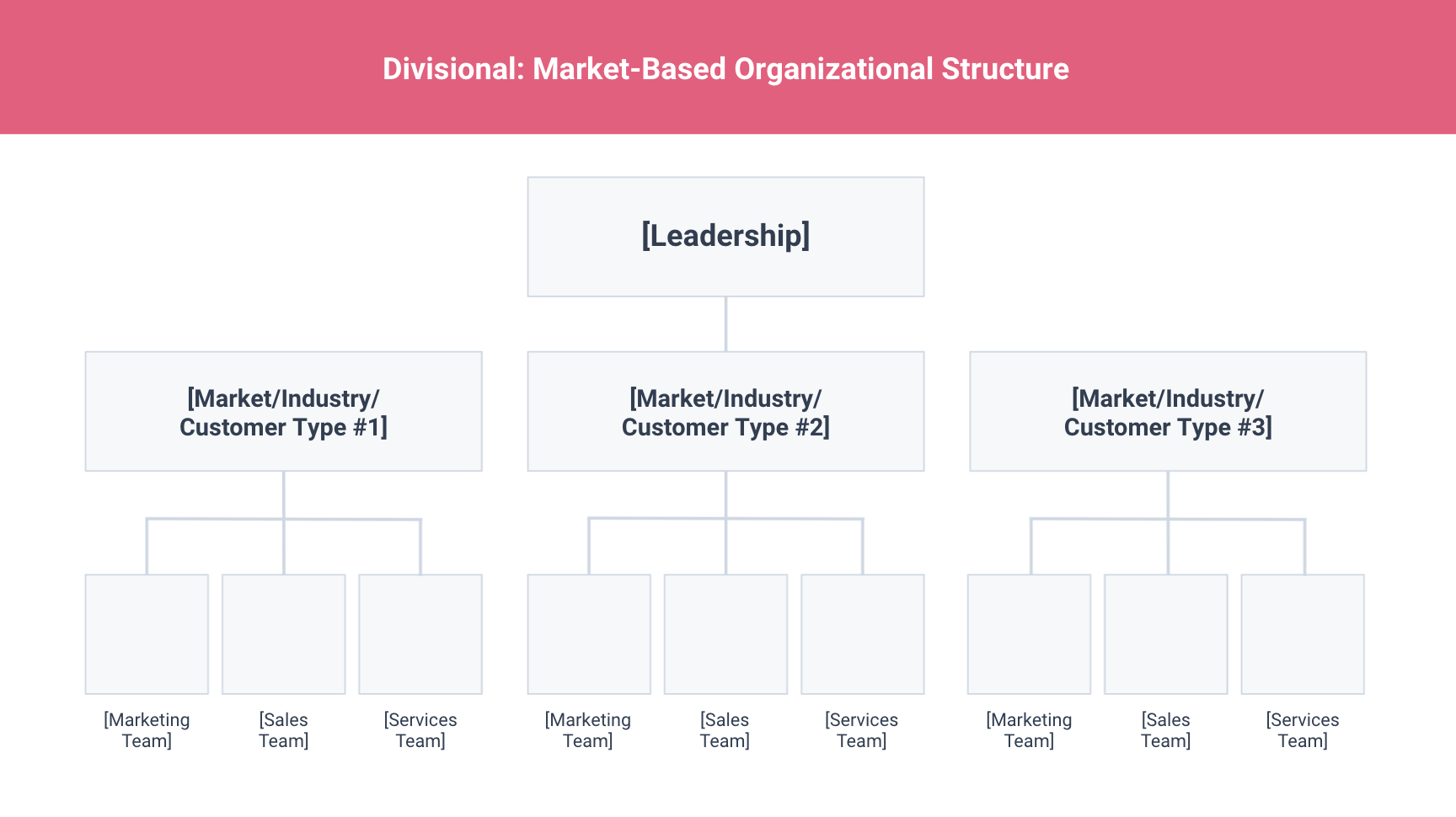 Download this Template
Download this TemplateDisadvantages
Advantages
4. Geographical Divisional Construction
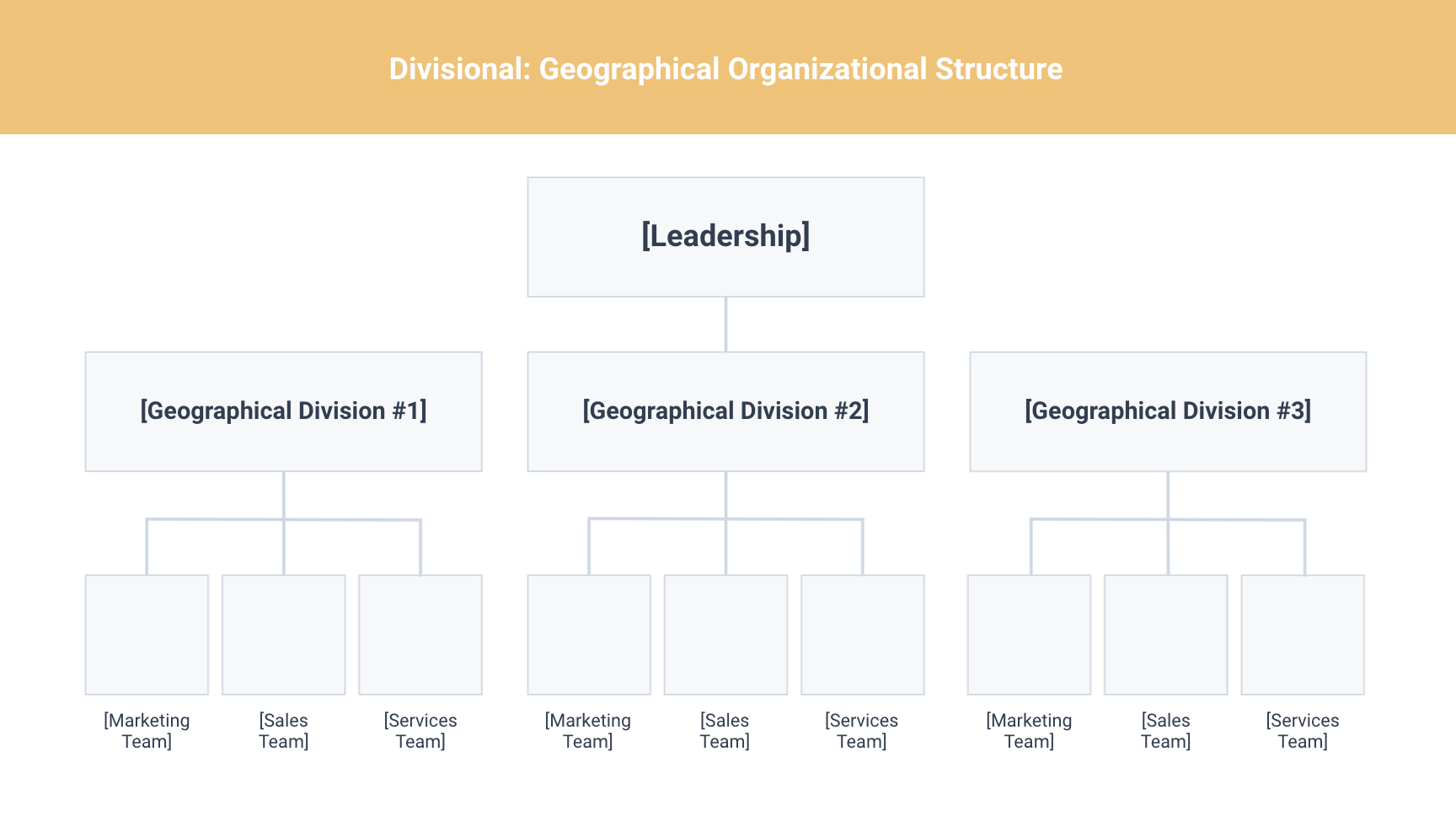 Download this Template
Download this TemplateDisadvantages
Advantages
5. Process-Based Structure
 Download the Template
Download the TemplateDisadvantages
Advantages
half dozen. Matrix Structure
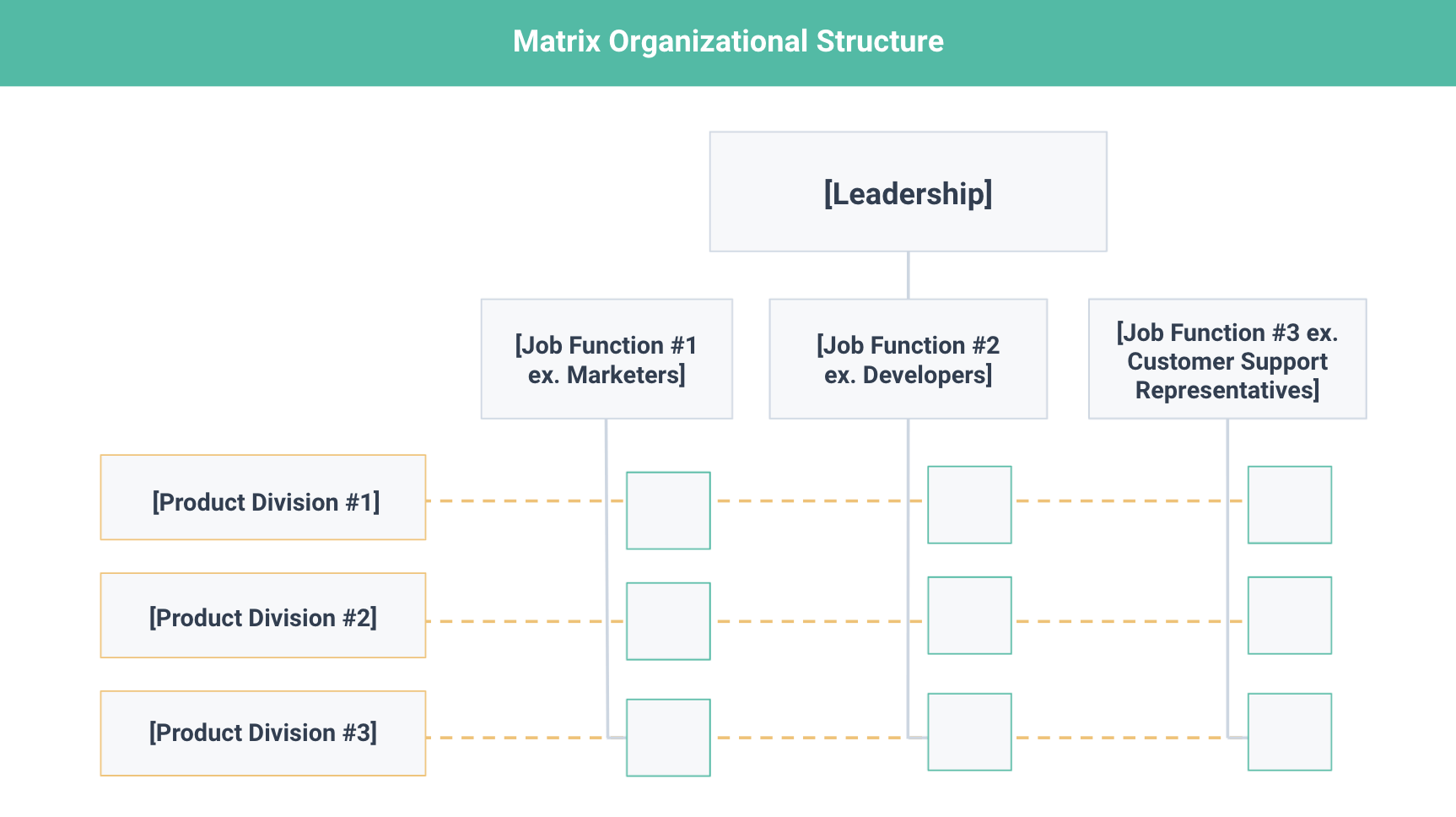 Download the Template
Download the TemplateDisadvantages
Advantages
7. Circular Structure
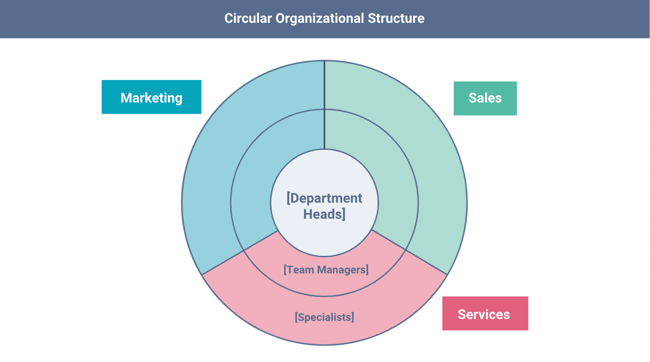
Disadvantages
Advantages
8. Flat Construction
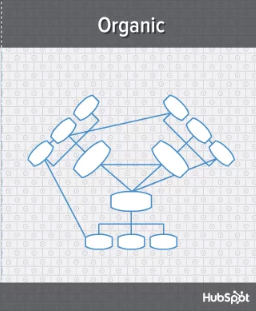 This structure is probably 1 of the most detailed, Information technology's also idea that employees can be more productive in an environment where there'southward less bureaucracy-related pressures. This structure might also make staff feel like the managers they do have are more like equals or team members rather than intimidating superiors.
This structure is probably 1 of the most detailed, Information technology's also idea that employees can be more productive in an environment where there'southward less bureaucracy-related pressures. This structure might also make staff feel like the managers they do have are more like equals or team members rather than intimidating superiors.Disadvantages
Advantages
9. Network Structure
Disadvantages
Advantages
Why is having an organizational structure important?
Navigating Organizational Structures


Originally published February 11, 2022 7:00:00 AM, updated February 11 2022
Source: https://blog.hubspot.com/marketing/team-structure-diagrams
Posted by: martinezboused.blogspot.com


0 Response to "Where Does Customer Service Fit On The Org Chart"
Post a Comment